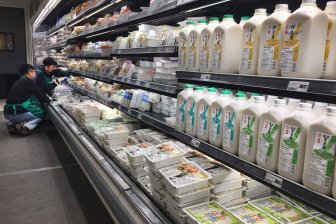Canadian consumers are paying artificially high prices for milk and cheese because U.S. exporters are being deliberately shut out of the market, despite promises made to let them in, an ongoing trade dispute alleges.
A tribunal ruled in December that Canada violated the terms of the Canada-United States-Mexico Agreement (CUSMA) by setting aside the vast majority of low-tariff imports from the U.S. exclusively for use by its own dairy processors.
Sending imports direct to processors means the trickle of milk and cheese coming into Canada is mainly being used in the food manufacturing process, such as butter used for croissants, or combined with Canadian dairy and packaged as a domestic brand.
“Canada’s tariff-rate quota administration policies fail to allow dairy exporters to Canada to effectively compete with domestic products,” said International Dairy Foods Association senior vice-president Matt Herrick.
“Global dairy industries … are simply asking that Canada allow [quotas] to function fairly and freely.”
Canada had 45 days to comply with its CUSMA obligations and agree on a way forward with the U.S. — a deadline which passed on Thursday.
It’s unclear whether Canada intends to comply or risk souring the bilateral relationship with its largest trading partner even further. Not complying could mean as much as $200 million a year in potential tariffs on Canadian goods entering the U.S.
Read more:
Dairy farmers pushed record-breaking price hike for milk even higher
The ruling comes as other major trade partners, such as New Zealand, argue they too are being shut out of the Canadian dairy market — despite promises to open it up under another trade deal, the Comprehensive and Progressive Agreement for Trans-Pacific Partnership (CPTPP).
Alice Hansen, a spokesperson for Canada’s trade minister Mary Ng, did not comment on when Canada would comply with the ruling, but said “we are working with the United States to resolve this.”
Herrick said on Thursday he was not aware if the deadline was met.
How Canada’s dairy market works
Canada has long sought to protect its domestic dairy industry from outside competition through its supply management system, which protects Canadian dairy from international competition by imposing massive border tariffs — as much as 300 per cent — on imported dairy products. The system also sets quotas for how much each farm in Canada can produce, and guarantees a “minimum” price for the milk they sell.
Supply management has been a point of contention among the world’s major dairy exporters for decades. Opponents say blocking access to the lucrative $16-billion annual domestic dairy market stamps out competition, results in oversupply in other markets, and artificially inflates prices for Canadian consumers.

Supply management is also largely credited for the prices Canadian consumers pay for milk, which are among the highest in the world.
A report on milk prices in June 2021 from digital marketing agency Field Agent Canada found that a 3.78 L jug of milk in Amherst, N.Y., costs $2.59 ($3.32 CAD) — 25 per cent less than the price of the cheapest Canadian 4 L jug, at $4.65. That price soared even further this week, after a record increase in the price farmers are paid for the milk they produce came into effect.
“There is no doubt that open borders would reduce the milk price for Canadian consumers,” the Field Agent report stated.
Why the U.S. says Canada is reneging on CUSMA promises
Dairy was one of the hardest-fought issues in negotiating CUSMA, and was resolved in the final days of the negotiation process.
Under the agreement, signed in July 2020, Canada agreed to provide U.S. dairy farmers access to about 3.5 per cent of its dairy market, without imposing prohibitive tariffs — known as a tariff-rate quota — on them.
After Canadian farmers argued this was taking shelf space away from Canadian products — following similar concessions in other trade deals — Prime Minister Justin Trudeau announced billions in compensation for Canadian farmers.

But over the past two years, the U.S. argues Canada has flouted those obligations by allocating the majority of that quota, 85 to 100 per cent, to its domestic processors.
Those processors rarely send international dairy products along to retailers to be sold as is, as they’re direct competitors. They instead use them in the food manufacturing process. It leaves consumers with only one option for dairy products at the supermarket: to buy Canadian.
Read more:
Milk prices soar across Canada as record price increases for farmers kick in
This has resulted in an average of 68 per cent of dairy import quotas — the allotment of tariff-free exports the U.S. can send into Canada — being filled under CUSMA since the deal was implemented.
The U.S. argues that if retailers, such as supermarkets, were able to take their products directly, more of the quotas would be used.
‘We are working to get this right’
In January, when the first-ever dispute case under CUSMA was made public, both the U.S. and Canada hailed the ruling a victory.
U.S. Trade Representative Katherine Tai said at the time the “historic win will help eliminate unjustified trade restrictions on American dairy products.”
The U.S. Government did not respond to multiple requests for comment for this story.
Alice Hansen, a spokesperson for Canada’s trade minister Mary Ng, told Global News on Wednesday that the report “ruled overwhelmingly in favour of Canada and our supply-managed dairy industry.”
“The report demonstrates that Canada takes its commitments and obligations under international agreements seriously.”

While the ruling found Canada at fault, it did state its supply management system was legitimate.
Hansen implied Canada missed the Feb 3 deadline, saying: “We are actively working with the United States to resolve this. While we don’t have an update on timing, we are working to get this right.”
“We are confident we will be able to meet the findings of the panel and we continue to work closely with industry and partners to reach a solution.”
Read more:
Alberta milk producers slam new North American trade agreement — ‘What do I do now?’
Herrick, of the International Dairy Foods Association, said dairy exporting countries are not asking the country to abolish supply management, but to “manage all aspects of it.”
“When Canada increases milk production to meet their butterfat needs and simultaneously creates barriers to the importation of butterfats, they must also accept the need to manage the [oversupply] that results without dumping these products on the world market at below cost of production prices.”
New Zealand also accuses Canada of trade infringements
New Zealand, the world’s largest dairy exporter, is also calling on Canada to fulfil its obligations under the CPTPP, saying it shares similar concerns as the U.S.
“Canada administers its dairy tariff rate quotas under CPTPP in a similar manner, and New Zealand has repeatedly maintained that this is inconsistent with Canada’s obligations,” says a spokesperson for New Zealand’s Ministry of Foreign Affairs and Trade.
“This is adversely affecting New Zealand exporters. It is also adversely affecting Canadian consumers, who are missing out on the increased consumer choice that (CPTPP) should be providing.”

The deal was supposed to open Canada’s dairy market to tariff-free exports from CPTPP countries, including New Zealand. But New Zealand says only as much as eight per cent of dairy quotas have been filled annually in the four years since the deal was implemented.
Dairy exporters argue the underfill is because Canada puts most of that quota in the hands of Canadian processors — a similar argument to the CUSMA spat between the U.S. and Canada.
The New Zealand government spokesperson said they have been “following the USMCA dispute closely” and are now considering “next steps” to address their own concerns.
Read more:
Here’s why New Zealand’s trade minister says ditching supply management helped their industries grow
Australia, another major dairy exporter and a member of the CPTPP, would not say if it too was facing issues with accessing the Canadian market.
A Department of Foreign Affairs and Trade spokesperson said, “Australia has an ongoing interest in the Canadian dairy market and will continue to engage with Canada on implementation of its dairy market access commitments under the (CPTPP).”
The remaining CPTPP members are not major dairy exporters.
Canada, meanwhile, responded to the allegations by saying it is meeting its commitments to dairy producers under the CPTPP and will “continue to be a fair trading partner” to every nation it has signed free trade deals with.
Canada’s dairy market has been contentious for decades
This isn’t the first time Canada’s dairy trade conduct has come under fire.
In 1998, the U.S. and New Zealand took their grievances with Canada’s milk class system and its tariff rate quotas for milk imports to the World Trade Organization (WTO).
As a result, Canada was forced to reform its supply system for sales of domestic milk and a separate scheme governing milk to be sold for export.
Elizabeth Kamber, trade policy manager at Dairy Company Association of New Zealand, argues a similar reform is needed now.
Kamber says other Canadian policies, like the milk class pricing system, which are designed to replace imports, have also contributed to poor import performance under CPTPP.

As part of CUSMA negotiations, Canada agreed to abolish its milk class 7 — heavily subsidized skim milk powder and milk proteins — which exporters argue undercuts them from the Canadian and international market.
The U.S. and New Zealand now argue that Canada has sidestepped this agreement by introducing another almost identical milk class: 4a.
“We find heavily subsidized Canadian dairy entering the global dairy market, distorting markets and introducing unfair competition,” Kamber said.
“It doesn’t make sense to us that Canada can be a competitive exporter of milk protein without the subsidization across Canadian milk classes – effectively paid for by the Canadian consumer in the form of high retail prices. “
© 2022 Global News, a division of Corus Entertainment Inc.






















Discussion about this post